Adverb Of PlaceAdverbs of place are adverbs that affect or define the meaning of a phrase by informing us where things occur. These words or phrases are referred to be spatial adverbs by certain educators. 
Whatever they are titled, these adverbs invariably answer the same question: Where? 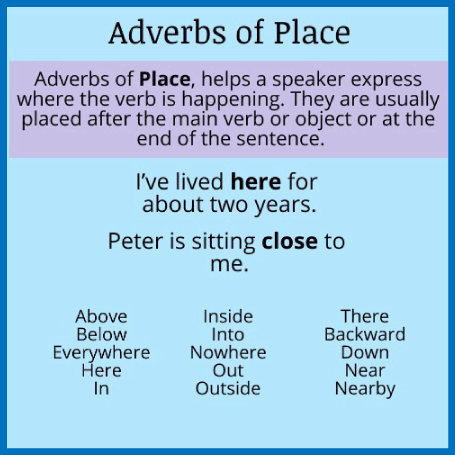
These easy principles for using an adverb of place will assist you to use them correctly:
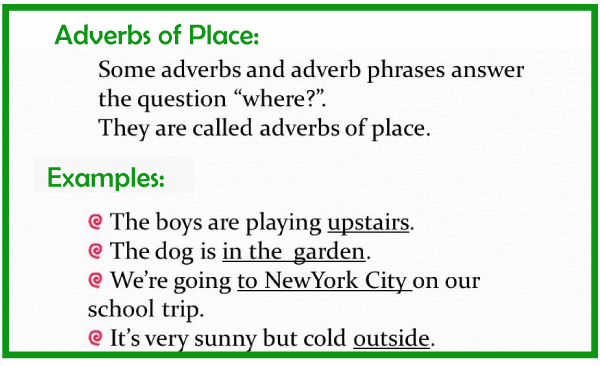
Adverbs of place that are commonly used include;Some of the most common adverbs of place are 'here' and 'there.' When the place is close to the speakers, we say 'here,' but when it is further away, we use 'there.' These terms can be used at the beginning or conclusion of a statement. As an example;
Movement: Adverb of PlaceMany adverbs follow a verb to convey a certain type of movement. As an example:
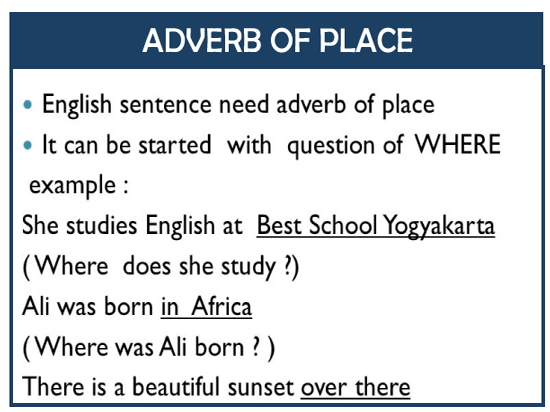
Direction : Adverb of PlaceSome adverbs assist us in indicating the direction of a movement. Again, these are usually used after the verb. As an instance:
Locations that are unknownTo refer to undefined locations, we utilize the adverbs somewhere, everywhere, anywhere, and nowhere. As an example:
So, now that you've seen the place adverbs, you're prepared to use them! Begin by reading and listening to them whenever possible. This will help you remember the different meanings and placements of these adverbs. How to use Adverbs of PlaceAn adverb of place is often used to describe the location where the verb's activity is taking place. Adverbs of place are typically used after the object or primary verb of a phrase. Place adverbs can be directional. Check out these easy adverbs of place rules to discover more about how to utilize adverbs of place correctly with your pupils:
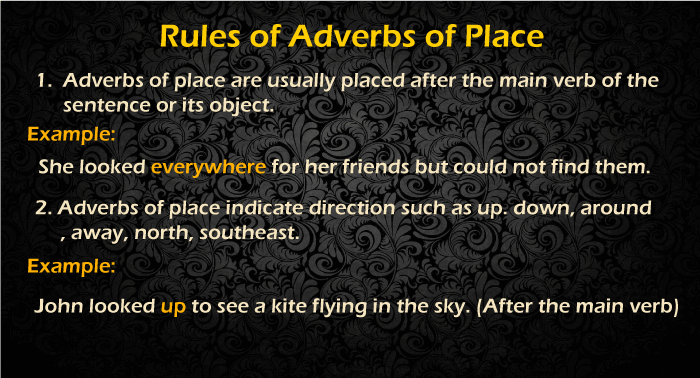
Adverb of place that can be prepositionsSeveral place adverbs could also be employed as prepositions. They must be utilized along a noun when it's being employed as prepositions. Here are some examples of place adverbs that are also prepositions: Adverb of place have been highlighted for ease of recognition;
Adverbs of Place Common ExamplesEvery statement includes an instance of an adverb of place; the instances are highlighted for ease of recognition. You'll note that some of the adverbs of the place include more than one term as you go through these examples.
Here and ThereAdverbs of place such as here and there are popular. They specify a location in relation to the speaker. When it comes to motion verbs, here denotes "towards or with the person speaking" while there indicates "away from or not with the person speaking."
Many typical adverbial phrases are formed by combining adverbs with prepositions here and there. Examples
When exclamations or emphasis are required, they are positioned at the start of a sentence. A verb accompanies them if the subject is a noun or a pronoun. Examples
Adverb of place that finishes with a term -wherePosition adverbs that end in -where indicate the concept of position without mentioning a specific area or direction. Anywhere is typically used in a negative phrase to indicate that an object cannot be located, as in I can't see my cards anywhere! In positive statements, use somewhere, and in negative statements, utilize anywhere. The meanings of these two adverbs are not the same. Examples
Adverb of place which end with -wardsAdverbs of place finishing with -wards showcase or depict movement in a certain direction. 
Examples
Keep in mind that because Towards is a preposition and not the adverb, it must be accompanied by a noun or a pronoun. Adverbs of place that conclude in 'ward' or 'wards' indicate travel in a certain direction. Adverbs such as eastwards and westwards are included, as are above, downwards, forwards, and backward. It is important to remember that 'towards' is all the time a preposition (not at all an adverb!) since it should be preceded by a noun or pronoun - for example, it is incorrect to say: He strolled towards. Whereas it is correct to say: He strolled towards me (object). Examples
Adverb of place that communicates both movements and the locations. Some place adverbs communicate both the movements and the locations at one time. Examples
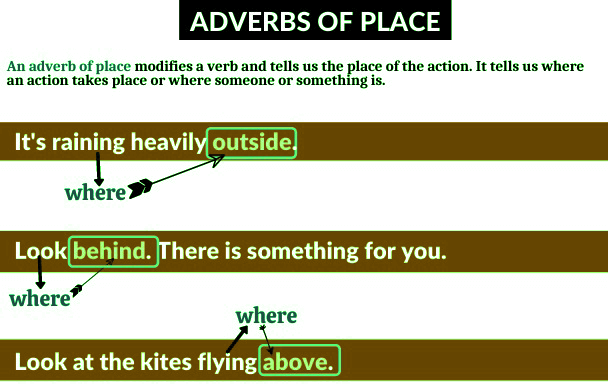
Adverbs of locationAdverbs are used to describe the location of something. An adverbial of location is a phrase that serves the same purpose as an adverb of place. It provides more detail about the verb. Here are several examples:
Some frequent place adverbs are used to construct adverbial phrases. 'There' and 'here' become nouns in these circumstances. As an example:
Sentence structure with Adverb of place
In a negative statement, the adverb's position doesn't really change. Subject + main verb + place adverb; for example, The girl didn't walk away. Place adverbs can also appear after the item.
In some of these cases, the combination of verb and adverb results in what is known as a "phrasal verb." Put away or leave behind are some examples. In this case, the adverb modifies (or expands) the verb's meanings. ConclusionThus conclusively, Adverb of place are classified as follows:
More practice and regular usage will help in better hold and understanding of the subject.
Next TopicAdverb of Degree
|
 For Videos Join Our Youtube Channel: Join Now
For Videos Join Our Youtube Channel: Join Now
Feedback
- Send your Feedback to [email protected]
Help Others, Please Share









